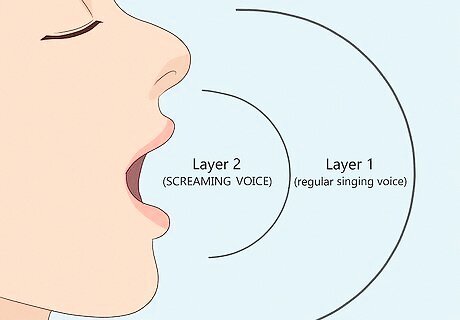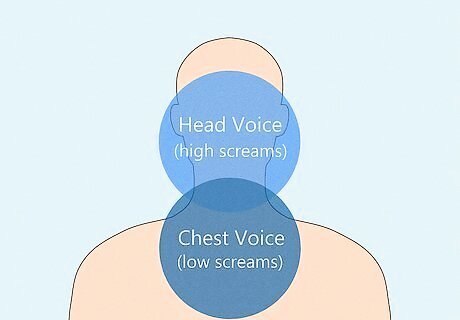
views
- Scream sing by inhaling deeply into your diaphragm and pushing out the air on an open vowel like “ah.” Slowly increase power until you produce a supported scream.
- To protect your voice, warm up with vocal scales, open your throat up with a silent laugh, stay hydrated, and rest your voice as needed.
- Fry screaming is the most common type of scream singing. Talk in a vocal fry by speaking without projection or breath, then try singing with that same creaky tone.
How to Scream Sing

Breathe from your diaphragm, not your chest. Your diaphragm is the muscle located below your lungs. When you take a deep breath to scream sing, move your stomach out while keeping your chest still. If you feel your chest lift a lot when you take in a breath, you’re breathing from your chest and not your diaphragm. Breathing properly through your diaphragm prevents unnecessary wear on your vocal cords.

Start with breathing techniques. Take a deep breath into your diaphragm until you feel your lungs filled with air–this should feel like your stomach and sides are expanding, not your chest. Exhale sharply making an “h” sound to clear your throat and open up your throat. Repeat this process but make an “ee” sound as you exhale, slowly letting out air. Remember the way it feels to support and control your breath when you’re scream singing so you can produce a more powerful and healthy scream.

Layer your screams over the notes you sing. Remember that you still want to be singing in tune when scream singing. You're not just screaming the words of a song; you're singing the words and adding screams to your singing. Think of it as two layers: your regular singing voice, then your screaming voice. Combine the two layers to create the scream-singing sound. Practice layering your screams over your singing voice by singing normally and gradually transitioning into scream singing. Choose a note and sing it in your regular voice. After holding the note for a few seconds, start to layer a scream over the note until you're scream singing the note.

Sing high screams in your head voice and low screams in your chest voice. These different types of screams come from various places in the body. Similar to regular singing, high-pitched screams come from the nasal cavity, and low-pitched screams come from the chest. Listen to a song that has scream singing in it and try to copy the placement of each scream. Don't copy the full screaming noise. Try a soft whisper scream so you can feel where each type of scream should be coming from in the body. The song "Painkiller" by Death features scream singing in the high vocal range. Listen to "Feed the Machine" by Red to hear low-note screams coming from the chest.

Use vocal fry to fry scream. Open your mouth and slowly let out a low "ah." Don't project your voice or breathe out as you're doing it. This low-pitched, cracking effect you hear in your voice is vocal fry. Choose a song you like and sing the words with vocal fry. Try getting louder with your vocal fry until it sounds like a scream. Singing using vocal fry can create a distorted, screaming-like effect that won’t hurt your voice. This vocal fry technique is known as fry screaming, which is the most common type of scream singing. Fry screaming is done by breathing deeply into the diaphragm and pushing that air through the vocal cords. Matt Shadows of the band Avenged Sevenfold uses vocal fry to scream sing. Listen to the song "Critical Acclaim" to hear him using vocal fry. Vocal fry is generated from the ventricular folds, which are different from vocal folds.

Work with a voice coach. A trained vocal professional can give you individual help with scream singing. Voice training can also help to make sure you don’t damage your voice, especially if your coach specializes in scream singing or other “aggressive” music genres.
Scream Sing Without Hurting Your Voice

Warm up your voice before you scream sing. Warm-ups prepare your voice for scream singing so it’s not as vulnerable to damage. Try to do a few different singing warm-ups before every practice session or performance. Start your warm-up with a simple lip buzz. Close your lips and then vibrate them so they’re rapidly hitting against each other. Hold your pitch for a few seconds and then go up or down a pitch. Keep vibrating your lips and trying different pitches. You can also warm up by singing “mah-may-me-mo-moo.” Using one note, sing “mah-may-me-mo-moo” slowly but all in one breath. Once you finish, sing it again, going one note higher. Continue until you’ve gone all the way up the scale. Sometimes, your voice might seem like it's not warmed up, but you're actually struggling because of something unrelated to your voice like nerves. Work on resolving the emotions that are interfering with your voice rather than focusing on technique. Cooling down your voice is as important as warming it up: try descending scales or slides on a lip trill or gentle vowel like “oo.”

Open up your throat. Try silently laughing, producing a silent sob, or inhale on a soft “k” sound. These actions will naturally reduce constriction in your throat and prepare it for a scream or shout.

Use proper posture that supports your voice. Engage your back muscles for more power by making a pulling motion with your arms as you scream sing. Bend your legs to center your body before a powerful scream. Stabilize your neck and chin by pressing your fist against your forehead while scream singing. Your chin should not lift or lower while singing. Eventually this posture will become second-nature to you, so you won’t have to repeat these motions every time you scream sing.

Use less air. Blow out most of your air right before your scream. It’s natural to want to take a big breath before a powerful note. However, more air in our lungs will want to rush out faster, which can lead to vocal strain. Singers can find it difficult to produce the same sounds with less air, but developing good breath control can help. Try this breath control exercise: Breathe in and fill your diaphragm, then push the air out on a whispered “ah.” Repeat the exercise and slightly increase the force of your breath. Narrow your vocal cords to control the sound and pitch.

Scream sing into a microphone to conserve your voice. Scream singing can place a lot of strain on your vocal cords, especially if you’re trying to project your voice. Use a microphone whenever you’re performing (or practicing if you want to sing loudly) so you don’t need to project your voice as far. Be careful not to scream sing too loudly into a microphone. You don't want to damage listeners' ears.

Drink water during breaks from singing. Whether you’re practicing or performing, keep your vocal cords hydrated while you’re scream singing. If you’re performing, bring a bottle of water on stage and take a few sips after each song.

Let your voice rest if your throat is irritated. Even with proper techniques, scream singing can wear out your voice. Continuing to sing with aching or damaged vocal cords will only make the problem worse. Listen to your body and take a break so your voice has time to heal.
Taking Care of Your Voice

Drink lots of water every day to keep your vocal cords hydrated. Try to drink 6-8 glasses of water a day. You can also drink warm tea with honey to help soothe your vocal cords if they feel irritated.

Cut back on alcohol and caffeine. Alcohol and caffeine dry out your larynx and vocal folds, making your voice more susceptible to damage when you sing. If you know you have a performance coming up or you’re going to be practicing a lot, limit your alcohol and caffeine intake during the days leading up to it.

Quit smoking. Smoking and inhaling second-hand smoke can irritate and damage your vocal cords. Combining smoking with scream singing will make your voice more susceptible to damage.

Try to exercise frequently. While it may not seem like exercising would have anything to do with your voice, regular exercise can improve your lung capacity and stamina, which will help you speak and sing better. Try to fit some cardio into your routine a few days out of the week.

Use a humidifier if you live in a cold or dry climate. A humidifier will work to keep your throat hydrated so your vocal cords don’t get too dry. Turn your humidifier on before you go to sleep every night. Try to keep your living space at around 30 percent humidity.




















Comments
0 comment